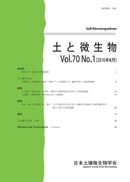Volume 72, Issue 1
Soil Microorganisms
Displaying 1-8 of 8 articles from this issue
- |<
- <
- 1
- >
- >|
-
2018Volume 72Issue 1 Pages 1
Published: 2018
Released on J-STAGE: April 30, 2018
Download PDF (590K) -
2018Volume 72Issue 1 Pages 2-6
Published: 2018
Released on J-STAGE: April 30, 2018
Download PDF (7575K) -
2018Volume 72Issue 1 Pages 7-13
Published: 2018
Released on J-STAGE: April 30, 2018
Download PDF (984K) -
2018Volume 72Issue 1 Pages 14-21
Published: 2018
Released on J-STAGE: April 30, 2018
Download PDF (1535K) -
2018Volume 72Issue 1 Pages 22-33
Published: 2018
Released on J-STAGE: April 30, 2018
Download PDF (2443K) -
2018Volume 72Issue 1 Pages 34-38
Published: 2018
Released on J-STAGE: April 30, 2018
Download PDF (520K) -
2018Volume 72Issue 1 Pages 39-49
Published: 2018
Released on J-STAGE: April 30, 2018
Download PDF (716K) -
2018Volume 72Issue 1 Pages 50-55
Published: 2018
Released on J-STAGE: April 30, 2018
Download PDF (2375K)
- |<
- <
- 1
- >
- >|
